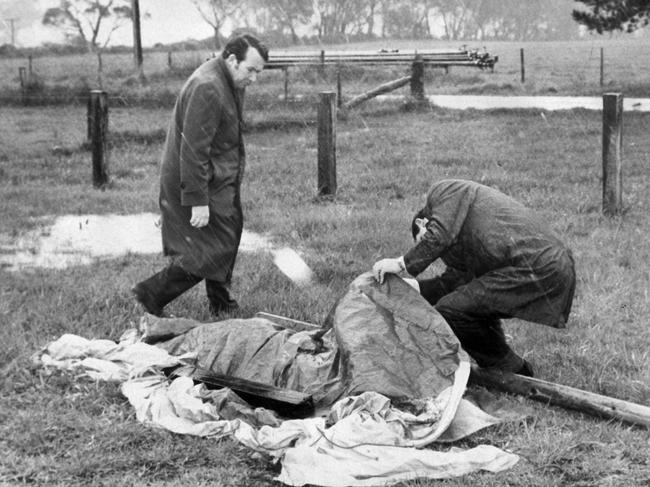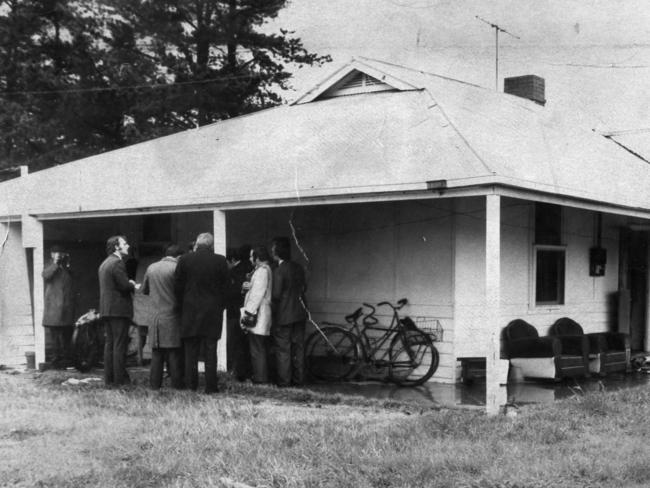Mass murderer Clifford Bartholomew’s secret life since leaving jail revealed by survivor who lived in fear until now
ONE of SA’s worst mass murderers is dead after living a secret life interstate. He slaughtered 10 members of his family, then served just eight years in jail. Now Clifford Bartholomew’s ultimate fate can finally be revealed.

National
Don't miss out on the headlines from National. Followed categories will be added to My News.
- Part 2: Bartholomew’s second family in Queensland speaks out
- Victim’s vengeance: ‘I hope he died in a terrible way’
- Why he snapped: Toxic suspicions and volcanic rage
ONE of South Australia’s worst mass-murderers — who slaughtered 10 members of his family — moved interstate and remarried under a new identity, it can now be revealed.
The whereabouts of Clifford Bartholomew have long been a mystery since he left prison after serving less than eight years for the massacre of his family at a Hope Forest farmhouse, outside Willunga, on September 7, 1971.
But the Sunday Mail can now reveal Bartholomew died 16 years ago, finally bringing relief to his fearful niece, who wants to know why she was not told until last week.
He changed his name to Clifford Palmer upon release from prison, remarried, and moved to Victoria and then on to Queensland in 1990.

It is in Queensland where Bartholomew is known to have died, aged 71, in 2002 — but it is unclear whether he told his second wife, who it is understood died 10 years later, about his sinister past.
Bartholomew’s niece, Noeleen Paltridge, 55, has been living in fear of “Uncle Barty” hunting her down and inflicting a final punishment.
“I’m glad he’s dead but there are a lot of questions I’d have liked to have asked him, face-to-face,” said Ms Paltridge, who still has regular nightmares about the killer.
“I just hope he died a horrible death like my family did.

“I hope his last few years were miserable and he died painfully of asbestosis or something.”
Bartholomew, a casual slaughterman at a nearby abattoir, used a .22-calibre single action rifle to shoot dead all his terrified victims — his wife Heather, their seven children, sister-in-law and her infant child.
Despite the terrible murder-suicide of seven people in Western Australia this month, the crimes of Bartholomew remain Australia’s worst incidence of a mass family killing.
Initially sentenced to hang for his heartless butchery, Bartholomew had his sentence commuted to life imprisonment by the Dunstan government, which was opposed to capital punishment.
But the decision by the South Australian Parole Board, led by Dame Roma Mitchell, to release him after less than eight years caused outrage in the community.
Ms Paltridge was shocked to hear Bartholomew had remarried.
“Don’t tell me he had more kids? I can’t bear that,” she said. “He got out in seven years for killing 10 people including eight kids … he stole their lives away and he stole mine, too. I was effectively left an orphan.
CLIFFORD BARTHOLOMEW’S VICTIMS


“It would have been good to know all this when he died.”
Her calls have been backed by the two police officers who attended the tragic scene, Allen Arthur and Bill Richter.
Now retired, Mr Arthur, 78, said he was grateful to know for certain Bartholomew was dead but wonders, given the 16 years since Bartholomew’s death, whether there could be a formal process that lets the public know sooner.
“I suppose once he’s out of the jurisdiction it’s a bit more difficult to know but perhaps there should be some system between law enforcement and governments to release this information sooner,” he said.
“It would have been good to know at the time because these things stay with you and I never had a case like this.”
Mr Arthur still has nightmares about the moment he picked up the phone before dawn to be told that 10 members of the same family had been murdered. It was September 7, 1971, and a cold, wet, miserable morning the day after Father’s Day.
He describes the scene inside the farmhouse as “obscene” and “an unimaginable horror” and he calls Bartholomew the most “hateful man he ever knew”.
“He’s already been on my mind again of late with what happened in Western Australia,” Mr Arthur said from his Middleton home.

“I was told his new name once but I made it my business to forget as soon as possible just in case something untoward happened to him.
“If he’s been a good boy you might give a pat on the back for the parole board but let’s face it, he got the bargain of the century.
“If he behaved himself, and we don’t know that, then so be it but my first reaction is if he’s gone he can do no harm. I don’t have any sympathy for the man.”
Mr Arthur was astonished to hear Bartholomew had married again and wonders if his second wife knew the fate of his first wife and family.
“I’m upset he appears to have had 23 years of happy life after he left prison … it’s quite shocking,” he said.
“What kind of happy lives did he destroy and what of those lives that never got to be fulfilled?”
Mr Richter, 78, and living in retirement at Port Lincoln, was quick to respond when hearing Bartholomew was dead.
“I’m glad he’s gone,” he said. “He should have died many, many years ago.
“It’s sad in one way to hear someone’s died and that you can rub your hands together with glee about it but that’s how I feel about that bloke.

“I’m pleased to finally hear it and now I don’t want to think of him ever again.”
Ms Paltridge only survived being a victim at the farmhouse after her stepbrother Terry Paltridge, 23, thought “something wasn’t right” at the Father’s Day gathering and decided to drive her back to Adelaide and not stay the night.
“I was never allowed to talk about this as a child and my mum (adoptive mother Daphne) even told me he was looking to kill me too,” Ms Paltridge said. “And people wonder why I’ve had mental issues most of my life.
“I can’t believe he was ever let out … my heart bleeds for these people who lose people to murder but every time a murderer gets a sentence of 20-30 years and you know they’ll serve it … it’s a slap in my face.”
Justice Roma Mitchell was the trial judge who sentenced Bartholomew to death on November 23, 1971.
As head of the SA Parole Board, she made the only public comment about why the mass murderer was being released after less than eight years. Justice Mitchell, who served for six years as Governor, defended the decision, saying it was “appropriate” and that Bartholomew had been a “model prisoner”.
Frances Nelson QC, head of the SA Parole Board for the past 35 years, but unavailable for comment, has previously stated she had seen the Bartholomew case files and that they contained “meagre information” for an assessment.
Bartholomew was released on parole on December 11, 1979, under supervision for only 10 years.

Unlike his colleague, Mr Richter did not consider it was likely Bartholomew would have murdered again.
“I don’t think he was that type … although when he came out I was no longer in the police but I got a call from CIB telling me Bartholomew had been mumbling about getting the coppers who pinched him,” he said.
“I felt he never paid his debt to society and it was disrespectful to his victims he should be out so soon.”
Both policemen agree that the most notorious crimes — and the Bartholomew murders were the worst they dealt with — should not be forgotten by society because there were still lessons to be learned.
And then there is the respect for the victims.
“I’m not looking for personal recognition but it’s important to keep this story in mind that bad things can happen and in a hurry,” Mr Arthur said.
“The sight of those 10 coffins crammed in at the Centennial Park Crematorium was hard to handle …. and I know it was the same for Bill.
“I think of the wonderful lives they all could have lived and I know those poor kids deserve for their murders to be remembered.”
Originally published as Mass murderer Clifford Bartholomew’s secret life since leaving jail revealed by survivor who lived in fear until now
